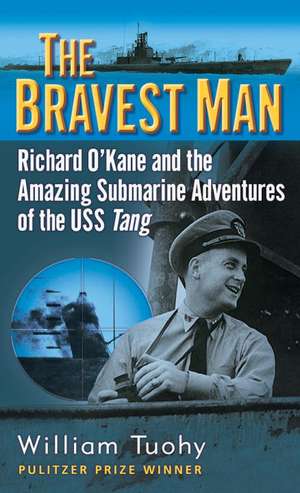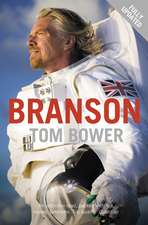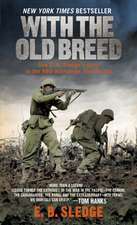The Bravest Man: Richard O'Kane and the Amazing Submarine Adventures of the USS Tang
Autor William Tuohyen Limba Engleză Paperback – 31 mai 2006
–Richard O’Kane
Hailed as the ace of aces, captain Richard O’Kane, winner of the Congressional Medal of Honor for his consummate skill and heroism as a submarine skipper, sank more enemy ships and saved more downed fliers than anyone else.
Now Pulitzer Prize—winning author William Tuohy captures all the danger, the terror, and the pulse-pounding action of undersea combat as he chronicles O’Kane’s wartime career–from his valiant service as executive officer under Wahoo skipper Dudley “Mush” Morton to his electrifying patrols as commander of the USS Tang and his incredible escape, with eight other survivors, after Tang was sunk by its own defective torpedo.
Above all, The Bravest Man is the dramatic story of mavericks who broke the rules and set the pace to become a new breed of hunter/killer submariners who waged a unique brand of warfare. These undersea warriors would blaze their own path to victory–and transform the “Silent Service” into the deadliest fighting force in the Pacific.
Preț: 55.40 lei
Nou
Puncte Express: 83
Preț estimativ în valută:
10.60€ • 11.34$ • 8.84£
10.60€ • 11.34$ • 8.84£
Carte disponibilă
Livrare economică 27 martie-10 aprilie
Preluare comenzi: 021 569.72.76
Specificații
ISBN-13: 9780891418894
ISBN-10: 089141889X
Pagini: 432
Dimensiuni: 108 x 176 x 25 mm
Greutate: 0.22 kg
Editura: Presidio Press
ISBN-10: 089141889X
Pagini: 432
Dimensiuni: 108 x 176 x 25 mm
Greutate: 0.22 kg
Editura: Presidio Press
Notă biografică
William Tuohy served with the U.S. Navy in the Pacific in 1945—46. He won the Pulitzer Prize in 1968 for his Vietnam War reporting in the Los Angeles Times. As a journalist, Tuohy covered the conflicts in the Middle East, Central America, Northern Ireland, and the Gulf, as well as covering the fall of Saigon in 1975 and the Berlin Wall in 1989. He is the author of Dangerous Company: Inside the World’s Hottest Trouble Spots with a Pulitzer Prize—winning War Correspondent. Tuohy divides his time between the United States and the United Kingdom.
Extras
Chapter One
“Wahoo is Expendable”
At the first, pale light on a January morning in 1943, Wahoo carved through the calm waters of the South Pacific with her crew at full alert. In the breaking, shimmering dawn, the sleek, matte-black American submarine strained on the surface at full speed, 18 knots, her powerful diesel engines leaving a boiling wake astern. Wahoo was approaching the Vitiaz Strait, a narrow waterway separating the Solomon Sea from the Bismarck Sea off the northeast coast of the big island of New Guinea. The strait was a maritime chokepoint, patrolled by Japanese aircraft and anti-submarine vessels from nearby New Britain Island—dangerous water for U.S. submarines.
Wahoo’s seventy-one crewmembers shared an edgy expectancy. They were embarked on a war patrol to seek out armed, enemy ships. They would be risking all. Thousands of miles from a friendly port, they would face the enemy alone. Defeat would mean death in their own iron coffin, in a nameless deep. They were heading into a no man’s sea, and Wahoo was fair game for foe, or even friend—patrol planes from Australia had a nasty habit of dropping bombs on American submarines. Normal doctrine called for Wahoo to dive beneath the surface at first light and proceed submerged. But the situation was not normal. Wahoo was holding to a breakneck pace to reach a Japanese-occupied harbor, and running on the surface would save precious hours.
Now, seven days out of the U.S. Submarine Base at Brisbane, Australia, Wahoo was several hours ahead of schedule heading for her patrol area around the Japanese-held Palau Islands east of the Philippines. En route to her assigned area, Wahoo had orders to make a slight detour, if possible, to reconnoiter the anchorage of Wewak on the north coast of New Guinea, captured by the Japanese in the conquest of the East Indies the year before. It was used by the Japanese as a staging area to support amphibious operations in the Solomon Islands chain. Thanks to her four powerful diesel engines Wahoo was able to maintain an 18-knot speed, almost 21 statute miles per hour. (A knot, a nautical mile per hour, is 1.15 statute miles an hour.) To fit in the requested reconnaissance, Wahoo was running at full speed on the surface despite the proximity of Japanese airfields. Submerged on batteries, her speed would have been reduced to 5 or 6 knots at best.
Though crewmembers were apprehensive, they were curiously confident. For Wahoo on her third war patrol was commanded by two officers whom they trusted, and whose leadership was soon to become famous throughout the U.S. Submarine Force. The sense of confidence was pointedly shared by the executive officer, Lieutenant Richard O’Kane, a handsome 31-year-old sailor with light-brown almost rusty hair, a strong jaw, firm set to his mouth, and an open face. Dick O’Kane was of medium height and in fine physical condition. A New England Yankee, O’Kane was energetic and outgoing, but sometimes sharp-tongued. His temperament was changeable, the crew thought. He could be voluble, or he could be quiet. The XO seemed by turns charming or curt, warm or irascible. But whatever his mood, he had a reputation as a hard-charger.
O’Kane put Wahoo into commission on June 15, 1942, as executive officer under then skipper, Commander Marvin Kennedy. O’Kane was delighted with the vessel’s name. U.S. fleet boats were named after marine life and a wahoo is a large, swift, game fish. But “Wahoo” sounded to O’Kane and the crew like the name of an Indian tribe. So her battle flag pictured an American Indian headdress.
Despite Wahoo’s early promise and well-trained crew, O’Kane, the number two, was frustrated at Captain Kennedy’s performance as skipper on the first two Pacific war patrols. He believed Kennedy was not aggressive enough, and failed to press attacks against choice enemy targets, including an aircraft carrier. Dick O’Kane decided he would not make a third war patrol under Marvin Kennedy. He would ask for a transfer off Wahoo.
O’Kane’s unstated feelings were shared by the enlisted men and other officers, and that mood translated into ragged morale among the crewmen, who were all volunteers prepared to risk their lives on patrol. Wahoo, with only one confirmed enemy ship sunk, had not made much of a record. Captain Kennedy may have had his excuses, but the crew did not want excuses. They wanted a good record. They wanted to sink enemy ships.
What buoyed the morale of Dick O’Kane and Wahoo’s men was the presence of a dynamic new skipper, Lieutenant Commander Dudley W. Morton, thirty-five, a tall, dark-haired, broad-shouldered athlete, with ham-hands, a friendly smile, and an approachable manner. Morton exuded confidence and ability. He was familiar with the crew, having made the second war patrol aboard Wahoo as the Prospective Commanding Officer—the PCO, or “makee-learn” in sub slang.
Kentucky-born and Florida-raised, Morton acquired his nickname, Mush, short for “Mushmouth,” at the Naval Academy because of his heavy Southern drawl. Mush Morton liked roaming the boat chatting with the sailors. Wahoo’s engineer, Lieutenant George Grider, thought Mush was built like a bear and playful as a cub.
Dick O’Kane was familiar with Mush Morton’s record. Morton was a varsity football player and wrestler who had been in command of the ancient submarine R-5 in the Atlantic. Mush had vainly fired two torpedoes at what he thought was a German U-boat. Transferred to the Pacific as a Prospective Commanding Officer (PCO), Morton was assigned to the venerable Dolphin as relief crew skipper. He looked the boat over, took her out on a training exercise off Pearl Harbor, and decided the sub was too creaky and should be retired—or assigned solely to training duties. “Dolphin is a death trap,” Morton told the executive officer. “I’m going to try to get off her. I advise you to do the same.”
This high-handed attitude, which branded Morton a maverick in the eyes of some squadron commanders, resulted in his removal from command of Dolphin. He was on the verge of being “surfaced” out of submarines to regular duty when he was rescued by a senior staffer, Captain John H. “Babe” Brown, also an Academy football player. Brown kept Morton in the PCO pool at Pearl Harbor. He was assigned as a PCO passenger aboard Wahoo for the second war patrol, which left Pearl Harbor traveling through the South Pacific to Brisbane. Mush Morton was determined to vindicate himself and Babe Brown’s confidence in him.
During Wahoo’s second patrol, Morton shared O’Kane’s view that Captain Kennedy was far too cautious. The higher authorities in Brisbane concurred, and on the last day of 1942, Mush Morton was given command of Wahoo.
Dick O’Kane was impressed by Mush Morton’s first action on taking control. Calling the crew together, Mush said quietly, “I am glad to have everyone of you aboard Wahoo personally. What I have to say can be stated simply. Wahoo is expendable. We will take every reasonable precaution, but our mission is to sink enemy shipping. We are going out there on this war patrol to search for Japs. Every smoke trace on the horizon, every contact on watch will be investigated. If it turns out to be the enemy, we are going to hunt him down and kill him.”
Morton paused. “Now if anyone doesn’t want to go along under these conditions, just see the yeoman. I am giving him verbal authority to transfer anyone who is not a volunteer. Nothing will ever be said about your remaining in Brisbane.”
A half-hour later, just before sailing time, Morton checked with Yeoman Second Class Forest J. Sterling, the ship’s clerk.
“Any customers, Yeo?”
“Not a one, Captain.”
Morton grinned. “That’s the kind of stuff I like in a crew.”
Now, sailing into combat, Wahoo had a captain and an executive officer who seemed to form a command team infused with fighting spirit, which radiated a mood of cockiness and assurance. Mush Morton clearly placed full trust in Dick O’Kane, and the exec repaid his skipper’s faith with loyalty and expertise.
Dick O’Kane was eager to fight. At the U.S. Sub Base in Brisbane a few days earlier, he learned that his first submarine, the elderly USS Argonaut, had been reported overdue and presumed lost—after a depth charging by a Japanese destroyer in waters near New Britain, not far from the Wahoo’s present transit area. What better way to avenge this personal loss, O’Kane thought, than by using the training he gained from Argonaut to help Wahoo score against the enemy? After three war patrols, O’Kane knew that submariners liked being on a boat with a good combat record. They wanted skippers and execs who could conduct a war patrol that would make them proud.
As for the crew’s view, Yeoman Sterling sensed Wahoo was different this time out, with a strong spirit growing in her. There was more of a feeling of freedom, of camaraderie, Sterling thought, of men being trusted to get their jobs done. The ship was no longer uptight but relaxed, though still taut and alert. The yeoman thought that Wahoo would make her own luck.
Heading for Wewak, Mush Morton posted additional lookouts at the bridge—rather than submerging at a much-reduced speed. Daylight surface running was a new innovation, since U.S. subs usually spent the day submerged when they were anywhere near enemy air searches. Morton’s bold tactic did not sit well with everyone. Some Wahoo junior officers, going into battle under the aggressive new skipper, had qualms—and wondered whether their skipper wasn’t taking too many chances. George Grider, a tall, thoughtful pipe-smoker from Memphis, Tennessee, believed some of Mush Morton’s bolder comments during Wahoo’s second patrol reflected the absence of a reasonable degree of caution. Running on the surface in daylight near Japanese airfields seemed to Grider to be rash, if invigorating. With Captain Morton on the bridge, Grider was Officer of the Deck (OOD) when the lookouts spotted a plane in the far distance. Grider prepared to scramble down the bridge hatch for the expected crash dive.
“Let’s wait till he gets in to six miles,” Mush Morton said quietly.
“Great Lord,” Grider thought, “we’re under the command of a madman.” The enemy plane closed to 61/2 miles and then veered away. By not diving, Morton saved hours. The tactic had worked, Grider grudgingly admitted, but he wasn’t sure he was in favor of it.
Entering Vitiaz Strait, from Wahoo’s flying bridge Captain Morton watched the skies for Japanese planes. A lookout reported a Mitsubishi bomber that had sneaked in four miles away.
“Clear the bridge,” Morton ordered. “Dive! Dive!”
“ahoogah, ahoogah.” Two raucous blasts sounded from the diving klaxon. Lookouts tumbled below through the bridge hatch to the conning tower, followed by Grider and Morton, who ordered, “Take her down.” The bridge hatch clanged shut. The Quartermaster dogged it down.
“Green board,” reported Chief of the Boat, Russell “Pappy” Rau at the “Christmas tree” control board. “Pressure in the boat.”
Wahoo slipped quickly beneath the surface. The main air induction valve had slammed shut with a wheeze. Water gurgled into the ballast tanks as air hissed and sputtered out. Throbbing diesels abruptly stopped as the ship shifted to battery-powered, electric drive to run smoothly under water. Wahoo was closing Wewak and Morton decided to run submerged the rest of the day.
In the control room, the officers discussed tactics. George Grider suggested that the instruction “reconnoiter” meant to take a periscope look outside Wewak harbor, and simply note the shipping activity.
Captain Morton countered, “No, boy, the only way you can reconnoiter a harbor is to go right into it and see what’s there.” With that, George Grider glanced in consternation at fellow officers—Roger Paine Jr., lean, dark-haired with a ready smile who ran the torpedo data computer; and Richie Henderson, tall, thin, and serious. It was clear, Grider decided, that the captain had advanced from rashness to outright foolhardiness. It would be crazy for Wahoo to submerge and enter an enemy harbor whose very location on the map they couldn’t pinpoint.
“Wahoo is Expendable”
At the first, pale light on a January morning in 1943, Wahoo carved through the calm waters of the South Pacific with her crew at full alert. In the breaking, shimmering dawn, the sleek, matte-black American submarine strained on the surface at full speed, 18 knots, her powerful diesel engines leaving a boiling wake astern. Wahoo was approaching the Vitiaz Strait, a narrow waterway separating the Solomon Sea from the Bismarck Sea off the northeast coast of the big island of New Guinea. The strait was a maritime chokepoint, patrolled by Japanese aircraft and anti-submarine vessels from nearby New Britain Island—dangerous water for U.S. submarines.
Wahoo’s seventy-one crewmembers shared an edgy expectancy. They were embarked on a war patrol to seek out armed, enemy ships. They would be risking all. Thousands of miles from a friendly port, they would face the enemy alone. Defeat would mean death in their own iron coffin, in a nameless deep. They were heading into a no man’s sea, and Wahoo was fair game for foe, or even friend—patrol planes from Australia had a nasty habit of dropping bombs on American submarines. Normal doctrine called for Wahoo to dive beneath the surface at first light and proceed submerged. But the situation was not normal. Wahoo was holding to a breakneck pace to reach a Japanese-occupied harbor, and running on the surface would save precious hours.
Now, seven days out of the U.S. Submarine Base at Brisbane, Australia, Wahoo was several hours ahead of schedule heading for her patrol area around the Japanese-held Palau Islands east of the Philippines. En route to her assigned area, Wahoo had orders to make a slight detour, if possible, to reconnoiter the anchorage of Wewak on the north coast of New Guinea, captured by the Japanese in the conquest of the East Indies the year before. It was used by the Japanese as a staging area to support amphibious operations in the Solomon Islands chain. Thanks to her four powerful diesel engines Wahoo was able to maintain an 18-knot speed, almost 21 statute miles per hour. (A knot, a nautical mile per hour, is 1.15 statute miles an hour.) To fit in the requested reconnaissance, Wahoo was running at full speed on the surface despite the proximity of Japanese airfields. Submerged on batteries, her speed would have been reduced to 5 or 6 knots at best.
Though crewmembers were apprehensive, they were curiously confident. For Wahoo on her third war patrol was commanded by two officers whom they trusted, and whose leadership was soon to become famous throughout the U.S. Submarine Force. The sense of confidence was pointedly shared by the executive officer, Lieutenant Richard O’Kane, a handsome 31-year-old sailor with light-brown almost rusty hair, a strong jaw, firm set to his mouth, and an open face. Dick O’Kane was of medium height and in fine physical condition. A New England Yankee, O’Kane was energetic and outgoing, but sometimes sharp-tongued. His temperament was changeable, the crew thought. He could be voluble, or he could be quiet. The XO seemed by turns charming or curt, warm or irascible. But whatever his mood, he had a reputation as a hard-charger.
O’Kane put Wahoo into commission on June 15, 1942, as executive officer under then skipper, Commander Marvin Kennedy. O’Kane was delighted with the vessel’s name. U.S. fleet boats were named after marine life and a wahoo is a large, swift, game fish. But “Wahoo” sounded to O’Kane and the crew like the name of an Indian tribe. So her battle flag pictured an American Indian headdress.
Despite Wahoo’s early promise and well-trained crew, O’Kane, the number two, was frustrated at Captain Kennedy’s performance as skipper on the first two Pacific war patrols. He believed Kennedy was not aggressive enough, and failed to press attacks against choice enemy targets, including an aircraft carrier. Dick O’Kane decided he would not make a third war patrol under Marvin Kennedy. He would ask for a transfer off Wahoo.
O’Kane’s unstated feelings were shared by the enlisted men and other officers, and that mood translated into ragged morale among the crewmen, who were all volunteers prepared to risk their lives on patrol. Wahoo, with only one confirmed enemy ship sunk, had not made much of a record. Captain Kennedy may have had his excuses, but the crew did not want excuses. They wanted a good record. They wanted to sink enemy ships.
What buoyed the morale of Dick O’Kane and Wahoo’s men was the presence of a dynamic new skipper, Lieutenant Commander Dudley W. Morton, thirty-five, a tall, dark-haired, broad-shouldered athlete, with ham-hands, a friendly smile, and an approachable manner. Morton exuded confidence and ability. He was familiar with the crew, having made the second war patrol aboard Wahoo as the Prospective Commanding Officer—the PCO, or “makee-learn” in sub slang.
Kentucky-born and Florida-raised, Morton acquired his nickname, Mush, short for “Mushmouth,” at the Naval Academy because of his heavy Southern drawl. Mush Morton liked roaming the boat chatting with the sailors. Wahoo’s engineer, Lieutenant George Grider, thought Mush was built like a bear and playful as a cub.
Dick O’Kane was familiar with Mush Morton’s record. Morton was a varsity football player and wrestler who had been in command of the ancient submarine R-5 in the Atlantic. Mush had vainly fired two torpedoes at what he thought was a German U-boat. Transferred to the Pacific as a Prospective Commanding Officer (PCO), Morton was assigned to the venerable Dolphin as relief crew skipper. He looked the boat over, took her out on a training exercise off Pearl Harbor, and decided the sub was too creaky and should be retired—or assigned solely to training duties. “Dolphin is a death trap,” Morton told the executive officer. “I’m going to try to get off her. I advise you to do the same.”
This high-handed attitude, which branded Morton a maverick in the eyes of some squadron commanders, resulted in his removal from command of Dolphin. He was on the verge of being “surfaced” out of submarines to regular duty when he was rescued by a senior staffer, Captain John H. “Babe” Brown, also an Academy football player. Brown kept Morton in the PCO pool at Pearl Harbor. He was assigned as a PCO passenger aboard Wahoo for the second war patrol, which left Pearl Harbor traveling through the South Pacific to Brisbane. Mush Morton was determined to vindicate himself and Babe Brown’s confidence in him.
During Wahoo’s second patrol, Morton shared O’Kane’s view that Captain Kennedy was far too cautious. The higher authorities in Brisbane concurred, and on the last day of 1942, Mush Morton was given command of Wahoo.
Dick O’Kane was impressed by Mush Morton’s first action on taking control. Calling the crew together, Mush said quietly, “I am glad to have everyone of you aboard Wahoo personally. What I have to say can be stated simply. Wahoo is expendable. We will take every reasonable precaution, but our mission is to sink enemy shipping. We are going out there on this war patrol to search for Japs. Every smoke trace on the horizon, every contact on watch will be investigated. If it turns out to be the enemy, we are going to hunt him down and kill him.”
Morton paused. “Now if anyone doesn’t want to go along under these conditions, just see the yeoman. I am giving him verbal authority to transfer anyone who is not a volunteer. Nothing will ever be said about your remaining in Brisbane.”
A half-hour later, just before sailing time, Morton checked with Yeoman Second Class Forest J. Sterling, the ship’s clerk.
“Any customers, Yeo?”
“Not a one, Captain.”
Morton grinned. “That’s the kind of stuff I like in a crew.”
Now, sailing into combat, Wahoo had a captain and an executive officer who seemed to form a command team infused with fighting spirit, which radiated a mood of cockiness and assurance. Mush Morton clearly placed full trust in Dick O’Kane, and the exec repaid his skipper’s faith with loyalty and expertise.
Dick O’Kane was eager to fight. At the U.S. Sub Base in Brisbane a few days earlier, he learned that his first submarine, the elderly USS Argonaut, had been reported overdue and presumed lost—after a depth charging by a Japanese destroyer in waters near New Britain, not far from the Wahoo’s present transit area. What better way to avenge this personal loss, O’Kane thought, than by using the training he gained from Argonaut to help Wahoo score against the enemy? After three war patrols, O’Kane knew that submariners liked being on a boat with a good combat record. They wanted skippers and execs who could conduct a war patrol that would make them proud.
As for the crew’s view, Yeoman Sterling sensed Wahoo was different this time out, with a strong spirit growing in her. There was more of a feeling of freedom, of camaraderie, Sterling thought, of men being trusted to get their jobs done. The ship was no longer uptight but relaxed, though still taut and alert. The yeoman thought that Wahoo would make her own luck.
Heading for Wewak, Mush Morton posted additional lookouts at the bridge—rather than submerging at a much-reduced speed. Daylight surface running was a new innovation, since U.S. subs usually spent the day submerged when they were anywhere near enemy air searches. Morton’s bold tactic did not sit well with everyone. Some Wahoo junior officers, going into battle under the aggressive new skipper, had qualms—and wondered whether their skipper wasn’t taking too many chances. George Grider, a tall, thoughtful pipe-smoker from Memphis, Tennessee, believed some of Mush Morton’s bolder comments during Wahoo’s second patrol reflected the absence of a reasonable degree of caution. Running on the surface in daylight near Japanese airfields seemed to Grider to be rash, if invigorating. With Captain Morton on the bridge, Grider was Officer of the Deck (OOD) when the lookouts spotted a plane in the far distance. Grider prepared to scramble down the bridge hatch for the expected crash dive.
“Let’s wait till he gets in to six miles,” Mush Morton said quietly.
“Great Lord,” Grider thought, “we’re under the command of a madman.” The enemy plane closed to 61/2 miles and then veered away. By not diving, Morton saved hours. The tactic had worked, Grider grudgingly admitted, but he wasn’t sure he was in favor of it.
Entering Vitiaz Strait, from Wahoo’s flying bridge Captain Morton watched the skies for Japanese planes. A lookout reported a Mitsubishi bomber that had sneaked in four miles away.
“Clear the bridge,” Morton ordered. “Dive! Dive!”
“ahoogah, ahoogah.” Two raucous blasts sounded from the diving klaxon. Lookouts tumbled below through the bridge hatch to the conning tower, followed by Grider and Morton, who ordered, “Take her down.” The bridge hatch clanged shut. The Quartermaster dogged it down.
“Green board,” reported Chief of the Boat, Russell “Pappy” Rau at the “Christmas tree” control board. “Pressure in the boat.”
Wahoo slipped quickly beneath the surface. The main air induction valve had slammed shut with a wheeze. Water gurgled into the ballast tanks as air hissed and sputtered out. Throbbing diesels abruptly stopped as the ship shifted to battery-powered, electric drive to run smoothly under water. Wahoo was closing Wewak and Morton decided to run submerged the rest of the day.
In the control room, the officers discussed tactics. George Grider suggested that the instruction “reconnoiter” meant to take a periscope look outside Wewak harbor, and simply note the shipping activity.
Captain Morton countered, “No, boy, the only way you can reconnoiter a harbor is to go right into it and see what’s there.” With that, George Grider glanced in consternation at fellow officers—Roger Paine Jr., lean, dark-haired with a ready smile who ran the torpedo data computer; and Richie Henderson, tall, thin, and serious. It was clear, Grider decided, that the captain had advanced from rashness to outright foolhardiness. It would be crazy for Wahoo to submerge and enter an enemy harbor whose very location on the map they couldn’t pinpoint.
Descriere
A Pulitzer Prize-winning author tells the action-packed true story of America's undersea aces of aces--Captain Richard O'Kane--and the fearless men he led in World War II's most heated submarine battles against the Japanese. Includes an 8-page photo insert.








